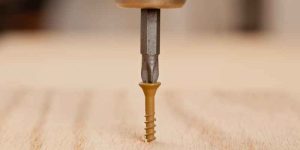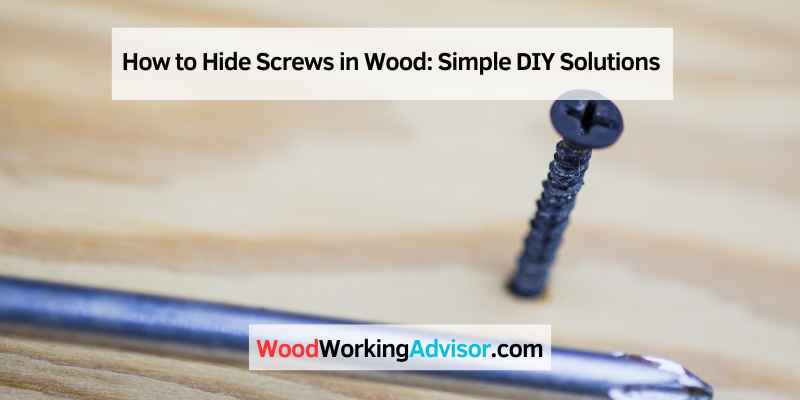To cover screws sticking out of wood, you can either put an adhesive screw cap or install a wood plug over the hole. Another option is to fill the hole with wood filler mixed with sawdust or use auto body filler for deep pocket holes.
If you want to keep the screw in place, you can peel back a surface layer of wood with a chisel and install your screw underneath it. Covering screws sticking out of wood is both aesthetically pleasing and functional. Protruding screws can be dangerous as they can cause injuries and damage to nearby objects.
There are different ways to cover screws sticking out of wood, such as using wood plugs, screw caps, or filling the hole with wood filler or auto body filler. We’ll go into more detail about each method and explain how to use them to cover screws sticking out of wood properly. So, let’s get started.
DIY Solutions For Hiding Screws In Wood
Discover effective DIY solutions for hiding screws in wood and achieving a seamless finish. From using pocket hole jigs, wood plugs, screw caps, to even adhesives and auto body fillers, there are several simple techniques that can help you cover screws sticking out of wood.
Screws that stick out of wood not only pose a safety hazard, but they can also ruin the overall look of your project. Luckily, there are various DIY solutions to hide protruding screw heads in wood. Here are some effective methods:
Using Wood Plugs
Wood plugs are small wooden pieces that can fit snuggly into screw holes, effectively covering the screws. Simply drill a hole slightly smaller than the plug, add a drop of woodworking glue into the hole, then tap the plug in with a hammer. After the glue dries, sand the plug’s surface level with the wood.
Using Screw Caps
Screw caps are small plastic or metal round covers that come in different colors, textures, and designs. They snap onto the screw head, hiding it from sight. Screw caps work best with screws that are flush or slightly below the wood surface.
Using Auto Body Filler
Auto body filler, also known as Bondo, can fill deep holes or gaps left by protruding screws. First, remove any debris or dust from the hole, mix the filler according to the manufacturer’s instructions, and apply it to the hole. Once it dries, use sandpaper to level the surface.
Using Adhesive Screw Caps
Adhesive screw caps look like small stickers and are a good solution for covering small screws. Simply remove the backing, and place the cap over the screw head.
Peeling Back Wood Surface
In some cases, you can peel back a layer of wood to expose the screw hole, and then install the screw deeper into the wood. This method works best for thin wood and requires a chisel and a steady hand.
Using Wood Filler
Wood filler, also known as wood putty, is a mixture of wood particles and adhesive. It can be used to fill small holes left by screws. Apply the wood filler to the hole and level it with a putty knife or scraper. Once it dries, sand the surface level with the wood.
Sanding Down Screws
If the protruding screw is only slightly above the wood surface, sanding it down may be an option. Use sandpaper with a fine grit, and sand the screw head until it is level with the wood.
Chiseling Away Wood
In some cases, you may need to chisel away a small amount of wood around the screw hole to allow the screw to sink deeper into the wood. This method requires some woodworking skills and may not be suitable for beginners.
In conclusion, these DIY solutions can help you hide screws protruding from your wood project, leaving a professional-looking finish. Whether you prefer wood plugs, screw caps, auto body filler, adhesive screw caps, peeling back wood, wood filler, sanding down screws, or chiseling away wood, choose the method that suits your project and woodworking skills.
Step-by-step Guide To Hiding Screws
Learn how to cover screws sticking out of wood with our step-by-step guide. You can use wood plugs, screws caps, or fillers to hide the screw heads and achieve a seamless finish. Watch our tutorial videos for more DIY tips and tricks.
Screws can prove troublesome when they stick out of wood, affecting the surface texture and overall appearance of your project. However, with the steps below, you can easily hide screws and achieve a polished finished result.
Prepping the Wood Surface
Ensure the wood surface is free of dirt, dust, and debris by wiping it with a clean cloth. This creates a smooth surface for the screw to sit in and ensures the cover material adheres effectively.
Creating the Pilot Hole
To prevent damage to the wood’s surface, it’s important to create a pilot hole before inserting the screw. The pilot hole should be marginally smaller than the screw diameter to ensure a tight grip and prevent the wood from splitting.
Inserting the Screw
Once the pilot hole is created, you can insert the screw into the wood and ensure it is flush with the surface. This is important because it makes it easier to apply a cover that matches the overall wood material.
Applying Filler or Cover
With the screw fully inserted, you can apply a filler or cover to hide it. This material should match the grain, texture, and color of the surrounding wood to ensure a seamless and organic fit. Popular cover materials include wood plugs, adhesive screw caps, and fillers.
Sanding and Finishing
After the filler or cover material is applied, allow it to dry. Check the cover material to determine the level of sanding required. Sand using a fine-grit sandpaper until you achieve a smooth and seamless finish that matches the rest of the wood surface. Finally, ensure you apply a finish of your choice to match the overall project look.
In conclusion, with the right tools and materials, hiding screws can be a simple and fun process. The steps above are instrumental in achieving a seamless finish that enhances the look of a woodworking project.
Additional Resources
Learn how to cover screws sticking out of wood with these helpful tips and tricks from DIY experts. From using wood plugs and pocket holes to sanding and staining techniques, there are plenty of ways to hide those unsightly screw heads and create a seamless finish.
If you’re still looking for more detailed solutions to cover screws sticking out of wood, there are plenty of online resources available that can help. Here are some of the best resources we’ve found on Reddit, YouTube, and online guides.
Reddit Threads
– Home Improvement Stack Exchange: With over 1.2 million members, this community is a great resource for DIY enthusiasts who are looking for helpful solutions to their home improvement projects. Here you can find several threads discussing the best ways to cover screws sticking out of wood.
YouTube Tutorials
– The Best Way to Cut Screws: Nails, Screws & Wall Hangings: In this YouTube video tutorial, you will learn some creative ways to cut screws and cover them up using different tools.
– How To Hide Screws In Wood | Cover Screw Heads Without Painting: This tutorial by How To Home covers everything you need to know about hiding screws in wood without painting and creating a flawless finish.
Online Guides
– Guide to Cover Caps: This guide from Essentra Components US provides valuable insights into the primary uses of cover caps and the benefits of using them to hide screw heads.
– How to Cover a Screw in Wood with Filler, Plugs, & More: This online guide by WikiHow details the different ways to fix screws sticking out of wood. The guide covers how to fill the hole with wood glue, sawdust, or auto body filler, or how to install adhesive screw caps or wood plugs.
With these additional resources at your fingertips, you can be sure to find the right solution for covering screws sticking out of wood. Each resource provides a unique perspective and method to deal with this issue, so it’s worth looking into each one before deciding on the best course of action for your project.

Frequently Asked Questions Of How To Cover Screws Sticking Out Of Wood
How Do You Cover Screws Poking Through Wood?
To cover screws that are poking through wood, you can use wood plugs, screw hiders, or adhesive screw caps. You can also fill the hole with wood glue mixed with sawdust or install your screw underneath a peeled-back surface layer of wood.
Grinding down the tip of the screw or using shorter screws are other options.
How Do You Hide Screws That Stick Out?
To hide screws that stick out, you can use wood plugs, cover caps, or an adhesive screw cap. Another option is to remove the screw, expand the hole, insert a plug, sand it, and apply a layer of stain. You can also chisel away a layer of wood and countersink the pilot hole before screwing the wood together.
Finally, you can cut the protruding part of the screw with a wire stripper or grind it down with a dremel or grinding wheel.
What Can I Use To Cover Exposed Screws?
To cover exposed screws, you can use cover caps or screw head covers to protect bolts and screws. Alternatively, you can put an adhesive screw cap or install a wood plug or filler to match the wood grain. If the screw is sharp and protruding, you can use sealant or grind it down.
You can also try sanding or flattening the screws if they are too long.
What To Do With Screws That Stick Out?
To fix screws that stick out, you can use wood plugs, screw caps, or auto body fillers. Cut the protruding screw with wire strippers or grind them down with a dremel or grinding wheel. To match the wood grain, fill the hole with wood filler or glue mixed with sawdust.
You can also chisel back a surface layer of wood and install the screw underneath it. Alternatively, you can cover the exposed screw with a decorative cap or nut cover to protect it from damage.
Conclusion
All in all, covering screws sticking out of wood is a simple and easy process, but it requires precision and patience to achieve a professional-looking finish. Whether you choose to use wood plugs, screw caps, or other techniques, the key is to carefully match the color and texture of the wood and ensure a tight fit.
By following the guidelines outlined in this post, you can confidently cover up those unsightly screw heads and enjoy a smooth, seamless finish on your wooden projects!


